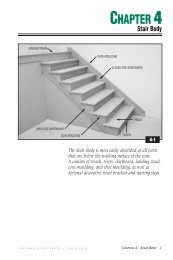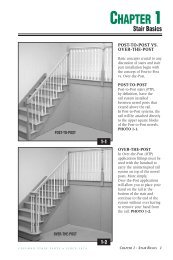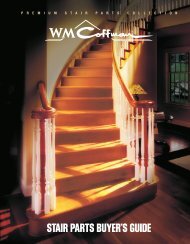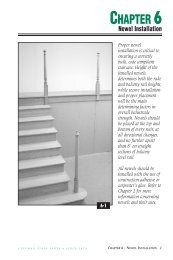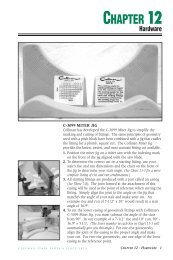Policies, Terms And Conditions Of Sale - WM Coffman
Policies, Terms And Conditions Of Sale - WM Coffman
Policies, Terms And Conditions Of Sale - WM Coffman
Create successful ePaper yourself
Turn your PDF publications into a flip-book with our unique Google optimized e-Paper software.
RAIL AND LINEAL BALUSTRADE COMPONENTS<br />
Rail and lineal balustrade components, like other lineal products, are<br />
offered in even lengths from 4' to 16'. For rake portions of the stair,<br />
measure along the slope of the stair or use the lineal formula:<br />
Number of Treads x 13" (rounded up to the nearest even length).<br />
SQUARE<br />
TOP<br />
BALUSTER<br />
PLOWED RAIL is moulded<br />
with a recessed bottom<br />
for insertion of square<br />
top balusters.<br />
UNPLOWED RAIL has a<br />
flat bottom that will be<br />
drilled for the insertion of<br />
pin top blausters.<br />
Ordering Specifications for Rails<br />
PIN TOP<br />
BALUSTER<br />
LINEAL RAIL COMPONENTS consist of sub rail, shoe rail, and<br />
fillet. Shoe rail is a plowed moulding designed to accept the<br />
bottom of the baluster. Sub rail is used under unplowed handrail<br />
with square top balusters in Post-to-Post systems to provide a<br />
more substantial look to the balustrade. Fillet is a finished<br />
moulding that will be installed between the balusters in plowed<br />
rail, shoe rail and sub rail.<br />
PLOWED RAIL<br />
SUB RAIL<br />
FILLET<br />
Check local building codes for required height and baluster spacing.<br />
SUB RAIL SHOE RAIL<br />
SHOE RAIL<br />
FILLET<br />
35<br />
BENDING RAIL BALUSTRADE COMPONENTS<br />
BENDING RAIL<br />
BENDING RAIL<br />
MINIMUM<br />
RADIUS<br />
BENDING<br />
MOULD<br />
The key components of curved rail construction are bending rails<br />
and bending moulds. Bending rail is most easily understood when<br />
imagining a standard rail profile cut into thin, vertical strips.<br />
Bending mould is a form, moulded to the outside profile of the<br />
handrail, that is used to cradle the bending rail as it is being<br />
shaped to the stair.<br />
Each ply comprising the bending rail is designed and<br />
manufactured with a tongue and groove bead to create an<br />
alignment of the plys. When assembled,<br />
<strong>WM</strong> <strong>Coffman</strong> bending rail results in a<br />
match of the standard rail profile.<br />
The minimum radius achievable with each rail profile will<br />
depend on several factors. These factors include such<br />
variables as the thickness of each ply, the overall<br />
thickness of the handrail, the height of the handrail, the<br />
angle of the stair, and whether the rail is bent on the<br />
rake or on the level portion of the stair. The minimum<br />
recommended radius for use on both rake and level<br />
applications are listed in the chart for each <strong>Coffman</strong><br />
bending rail profile.<br />
RAIL ITEM RAKE RAIL BALCONY RAIL<br />
TRADITIONAL C-6016 42" 48"<br />
BRISTOL C-6116 48" 54"<br />
CLASSIC C-6216 48" 54"<br />
RICHMOND C-6416 48" 54"<br />
MARION C-6716 48" 54"<br />
CHIPPENDALE C-6716 48” 54”



